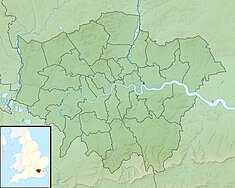Bankside Power Station
| Bankside Power Station | |
|---|---|

Bankside 'B' Power Station, about 1985, before conversion to the Tate Modern
|
|
|
Location of the Bankside Power Station in Greater London
|
|
| Official name | Bankside Power Station |
| Country | England, United Kingdom |
| Location | Greater London |
| Coordinates | 51°30′26″N 0°05′55″W / 51.5071°N 0.0985°WCoordinates: 51°30′26″N 0°05′55″W / 51.5071°N 0.0985°W |
| Status | Decommissioned |
| Construction began | 1891 (Pioneer Station), 1893 (A Station), 1947 (B Station) |
| Commission date | 1891 (Pioneer Station), 1893 (A Station), 1952 (B Station) |
| Decommission date | 1959 (A Station), 1981 (B Station) |
| Owner(s) | As operator(s), plus CEGB (1981-1990), Nuclear Electric (1990-1994); Tate Gallery 1994-date |
| Operator(s) | City of London Electric Lighting Company Limited (1891-1948), British Electricity Authority (1948–55), Central Electricity Authority (1955–57), CEGB (1958–81) |
| Thermal power station | |
| Primary fuel | Coal (A Station), Oil 'Bunker C' (B Station) |
| Power generation | |
| Nameplate capacity | 89 MW (A Station), 300 MW (B Station) |
Bankside Power Station was a former electricity generating station located on the south bank of the River Thames, in the Bankside area of the Borough of Southwark, London. It generated electricity from 1891 to 1981. Since 2000 the building has been used to house the Tate Modern art museum and gallery.
The pioneer Bankside power station was built at Meredith Wharf Bankside in 1891. It was owned and operated by the City of London Electric Lighting Company Limited (CLELCo) and supplied electricity to the City and to part of north Southwark. The generating equipment was installed by the Brush Electrical Engineering Company and comprised two pairs of 25 kW Brush arc-lighters and two 100 kW single phase alternators generating at 2 kV and 100 Hz. This equipment first supplied direct current (DC) electricity to arc lamp street lights in Queen Victoria Street on 25 June 1891.Alternating current (AC) for domestic and commercial consumers was first supplied on 14 December 1891, this was a single-phase, 100 Hz, three-wire, 204/102 Volt system. Electricity cables were carried over Southwark bridge and Blackfriars bridge.
The power station, later known as Bankside A, was extended several times as the demand for electricity grew.
An engine room, 230 ft (70 m) long and 50 ft (15 m) wide, was built in 1893 with two 200 kW, two 350 kW and two 400 kW alternators driven by Willans engines. The associated boiler house was the same length and had nine Babcock and Wilcox boilers. In 1895 the engine room was extended to 424 ft (129 m) and the boiler house to 300 ft (91 m) containing 22 boilers.
A DC supply for the printing presses of Fleet Street was provided from a DC power house at Bankside built in 1900.
...
Wikipedia

